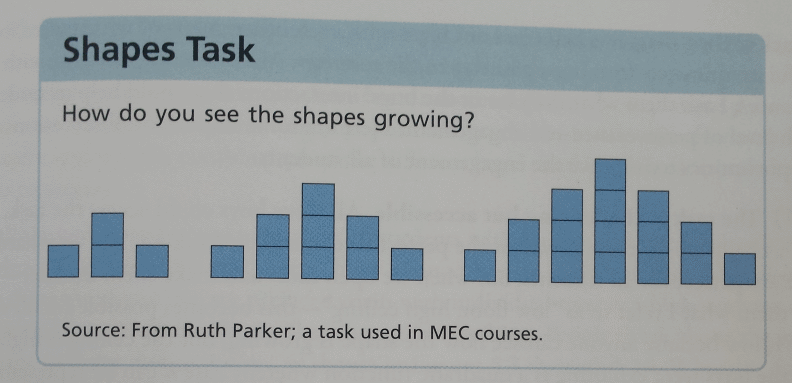Teachers are the most important resource for students. They are the ones who can create exciting mathematics environments, give students the positive messages they need, and take any math’s task and make it one that piques students’ curiosity and interest.
Interestingly, I found that mathematics excitement looks exactly the same for struggling 11-year-olds as it does for high-flying students in top universities – it combines curiosity, connection making, challenge, and creativity, and usually involves collaboration. These, for me, are the 5 C’s of mathematics engagement.
Boaler, Mathematical Mindsets
5 cases of true mathematics excitement (This is just an overview of those cases. What is valuable and probably can’t be conveyed in this blog post is the discussions that occurred during these tasks.)
Case 1. Seeing the Openness of Numbers
With a Silicon Valley start-up group that were looking to develop an online mathematics course the author when asked to what makes a good maths question, they stopped the conversation and asked the group if they could ask them all a math question. The author enacted a mini version of a number talk. They asked everyone to think about the answer to 18 X 5 and to show her, with a silent thumbs-up, when they had an answer. The team then shared their methods and there were at least six different methods. The author drew them up visually. It was the sharing and discussion around these methods that created the engagement and excitement in understanding that there were so many ways to think about an abstract number problem.
Mathematics is a subject that allows for precise thinking, but when that precise thinking is combined with creativity, flexibility, and multiplicity of ideas, the mathematics comes alive for people. Teachers can create such mathematical excitement in classrooms, with any task, by asking students for the different ways they see and can solve tasks and by encouraging discussion of different ways of seeing problems.
Case 2. Growing Shapes: The Power of Visualisation
Middle School classroom in San Francisco Bay Area. The focus was algebra, but not algebra as an end point, with students mindlessly solving for x. Instead, algebra was taught as a problem-solving tool tha could be used to solve rich, engaging problems. The students had just finished sixth and seventh grades, and most of them hated maths. Approximately half the students had received a D or an F in their previous school year.
The task that created the case of mathematics excitement came from Ruth Parker; it asked students to extend the growing pattern shown below:
The success of the task was in the discussions particularly with a number of difficult boys and remained on task for 70 minutes. Some of their work below:
Here are some important observations that reveal opportunities to improve the engagement of all students:
- The task is challenging but accessible
- The boys saw the task as a puzzle
- The visual thinking about the growth of the task gave the boys understanding of the way the pattern grew
- They had all developed their own way of seeing the pattern growth
- The classroom had been set up to encourage students to propose ideas without being afraid of making mistakes
- Taught the students to respect each other’s thinking
- Using their own ideas
- Working together
- Boys were working heterogeneously
Another way of solving the problem that led to discussions about why the pattern was growing as a square, why it was (n + 1) squared.
Case 3. A Time to Tell?
When I share open, inquiry-based mathematics tasks with teachers, such as the growing shapes or “raindrop” task just discussed, they often ask questions such as, “I get that these tasks are engaging and create good mathematical discussions, but how do students learn new knowledge, such as trig functions? Or how to factorize? They can’t discover it.”
The traditional approach has been Teachers show the method and then students use them.
Researchers have found that when students were given problems to solve, and they did not know methods to solve them, but they were given opportunity to explore the problems, became curious, and their brains were primed to learn new methods, sot that when Teachers taught the methods, students paid greater attention to them and were more motivated to learn them.
So the question is not about whether we should tell or explain methods but when is the most appropriate time. The student showed clearly that the best time was after students had explored the problems.
Case 6. From Math Facts to Math Excitement
Game: How close to 100
2 dice and a 100 grid. Multiply the two numbers and colour in the squares. Working towards filling the grid.
The following are some of the students’ important words as they reflected on the game:
- “It challenged me to make my brain think.”
- “It was a fun way to explore math and learn.”
- “It gave me a lot of practice with multiplication.”
- “It’s a fun way to learn multiplication facts.”
- “I learned that multiplication and area are related.”
- “I know now how division, multiplication, and area are related because I can see it!”
Conclusion
When mathematics tasks are opened for different ways of seeing, different methods and pathways, and different representations, everything changes. To summarise there are 5 suggestions that can work to open mathematics tasks and increase their potential for learning:
- Open up the task so that there are multiple methods, pathways, and representations.
- Include inquiry opportunities.
- Ask the problem before teaching the method.
- Ask a visual component and ask students how they see the mathematics.
- Extend the task to make it lower floor and higher ceiling.
- Ask students to convince and reason; be sceptical.
Resources:




